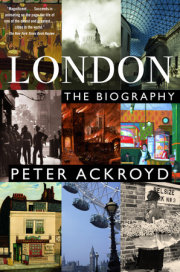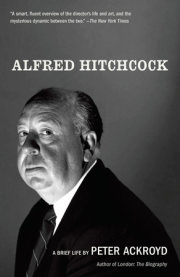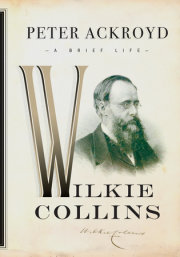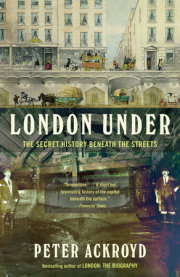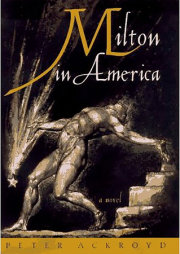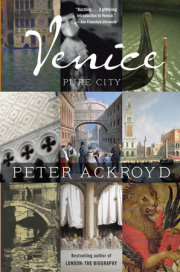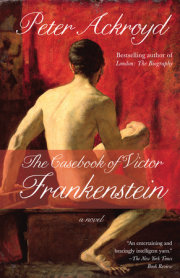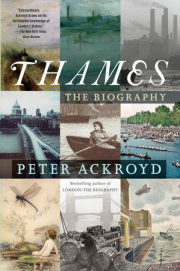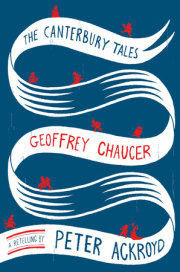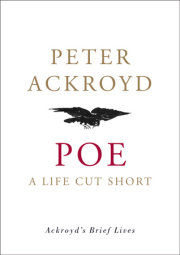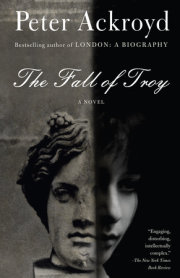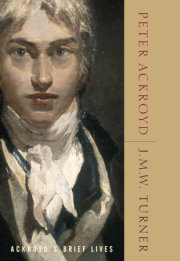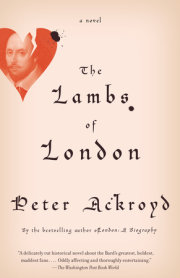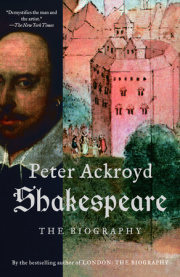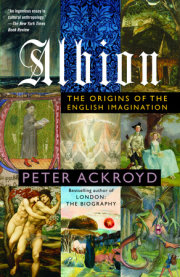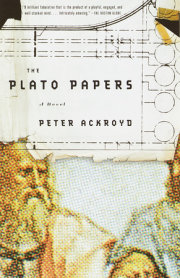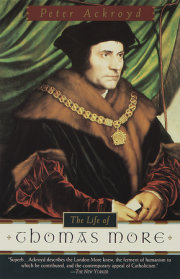Chapter 1
The Sea!
If you were to touch the plinth upon which the equestrian statue of King Charles I is placed, at Charing Cross, your fingers might rest upon the projecting fossils of sea lilies, starfish or sea urchins. There is a photograph of that statue taken in 1839; with its images of hackney cabs and small boys in stove-pipe hats the scene already seems remote, and yet how unimaginably distant lies the life of those tiny marine creatures. In the beginning was the sea. There was once a music-hall song entitled "Why Can't We Have the Sea in London?," but the question is redundant; the site of the capital, fifty million years before, was covered by great waters.
The waters have not wholly departed, even yet, and there is evidence of their life in the weathered stones of London. The Portland stone of the Customs House and St. Pancras Old Church has a diagonal bedding which reflects the currents of the ocean; there are ancient oyster shells within the texture of Mansion House and the British Museum. Seaweed can still be seen in the greyish marble of Waterloo Station, and the force of hurricanes may be detected in the "chatter-marked" stone of pedestrian subways. In the fabric of Waterloo Bridge, the bed of the Upper Jurassic Sea can also be observed. The tides and storms are still all around us, therefore, and as Shelley wrote of London "that great sea . . . still howls on for more."
London has always been a vast ocean in which survival is not certain. The dome of St. Paul's has been seen trembling upon a "vague troubled sea" of fog, while dark streams of people flow over London Bridge, or Waterloo Bridge, and emerge as torrents in the narrow thoroughfares of London. The social workers of the mid-nineteenth century spoke of rescuing "drowning" people in Whitechapel or Shoreditch and Arthur Morrison, a novelist of the same period, invokes a "howling sea of human wreckage" crying out to be saved. Henry Peacham, the seventeenth-century author of The Art of Living in London, considered the city as "a vast sea, full of gusts, fearful-dangerous shelves and rocks," while in 1810 Louis Simond was content to "listen to the roar of its waves, breaking around us in measured time."
If you look from a distance, you observe a sea of roofs, and have no more knowledge of the dark streams of people than of the denizens of some unknown ocean. But the city is always a heaving and restless place, with its own torrents and billows, its foam and spray. The sound of its streets is like the murmur from a sea shell and in the great fogs of the past the citizens believed themselves to be lying on the floor of the ocean. Even amid all the lights it may simply be what George Orwell described as "the ocean bottom, among the luminous, gliding fishes." This is a constant vision of the London world, particularly in the novels of the twentieth century, where feelings of hopelessness and despondency turn the city into a place of silence and mysterious depths.
Yet, like the sea and the gallows, London refuses nobody. Those who venture upon its currents look for prosperity or fame, even if they often founder in its depths. Jonathan Swift depicted the jobbers of the Exchange as traders waiting for shipwrecks in order to strip the dead, while the commercial houses of the City often used a ship or boat as a weather-vane and as a sign of good fortune. Three of the most common emblems in urban cemeteries are the shell, the ship and the anchor.
The starlings of Trafalgar Square are also the starlings who nest in the cliff faces of northern Scotland. The pigeons of London are descended from the wild rock-doves who lived among the steep cliffs of the northern and western shores of this island. For them the buildings of the city are cliffs still, and the streets are the endless sea stretching beyond them. But the real confluence lies in this--that London, for so long the arbiter of trade and of the sea, should have upon its fabric the silent signature of the tides and waves.
And when the waters parted, the London earth was revealed. In 1877, in a characteristically grand example of Victorian engineering, a vast well was taken down 1,146 feet at the southern end of Tottenham Court Road. It travelled hundreds of millions of years, touching the primeval landscapes of this city site, and from its evidence we can list the layers beneath our feet from the Devonian to the Jurassic and the Cretaceous. Above these strata lie 650 feet of chalk, outcrops of which can be seen upon the Downs or the Chilterns as the rim of the London Basin, that shallow saucer-like declivity in which the city rests. On top of the chalk itself lies the thick London clay which is in turn covered by deposits of gravel and brick-earth. Here, then, is the making of the city in more than one sense; the clay and the chalk and the brick-earth have for almost two thousand years been employed to construct the houses and public buildings of London. It is almost as if the city raised itself from its primeval origin, creating a human settlement from the senseless material of past time.
This clay is burned and compressed into "London Stock," the particular yellow-brown or red brick that has furnished the material of London housing. It truly represents the genius loci, and Christopher Wren suggested that "the earth around London, rightly managed, will yield as good brick as were the Roman bricks . . . and will endure, in our air, beyond any stone our island affords." William Blake called the bricks of London "well-wrought affections" by which he meant that the turning of clay and chalk into the fabric of the streets was a civilising process which knit the city with its primeval past. The houses of the seventeenth century are made out of dust that drifted over the London region in a glacial era 25,000 years before.
The London clay can yield more tangible evidence, also: the skeletons of sharks (in the East End it was popularly believed that shark's teeth might cure cramp), the skull of a wolf in Cheapside, and crocodiles in the clay of Islington. In 1682 Dryden recognised this now forgotten and invisible landscape of London:
Yet monsters from thy large increase we find
Engender'd on the Slyme thou leav'st behind.
Eight years later, in 1690, the remains of a mammoth were found beside what has since become King's Cross.
London clay can by the alchemy of weather become mud, and in 1851 Charles Dickens noted that there was so "much mud in the streets . . . that it would not be wonderful to meet a Megalosaurus, forty feet long or so, waddling like an elephantine lizard up Holborn Hill." In the 1930s Louis-Ferdinand C*line took the motor buses of Piccadilly Circus to be a "herd of mastodons" returning to the territory they had left behind. In Mother London Michael Moorcock's late twentieth-century hero sees "monsters, by mud and giant ferns" while crossing the footbridge alongside the Hungerford railway bridge.
The mammoth of 1690 was only the first primeval relic to be discovered in the London region. Hippopotami and elephants lay beneath Trafalgar Square, lions at Charing Cross, and buffaloes beside St. Martin-in-the-Fields. A brown bear was discovered in north Woolwich, mackerel in the old brick-fields of Holloway and sharks in Brentford. The wild animals of London include reindeer, giant beavers, hyenas and rhinoceri which once grazed by the swamps and lagoons of the Thames. And that landscape has not entirely faded. Within recent memory the mist from the ancient marshes of Westminster destroyed the frescoes of St. Stephen's. It is still possible, beside the National Gallery, to detect the rise of ground between the middle and upper terraces of the Thames in the Pleistocene era.
This was not, even then, an unpeopled region. Within the bones of the King's Cross mammoth were also found pieces of a flint hand-axe which can be dated to the Palaeolithic period. We can say with some certainty that for half a million years there has been in London a pattern of habitation and hunting if not of settlement. The first great fire of London was started, a quarter of a million years ago, in the forests south of the Thames. That river had by then taken its appointed course but not its later appearance; it was very broad, fed by many streams, occluded by forests, bordered by swamps and marshes.
The prehistory of London invites endless speculation and there is a certain pleasure to be derived from the prospect of human settlement in areas where, many thousands of years later, streets would be laid out and houses erected. There is no doubt that the region has been continually occupied for at least fifteen thousand years. A great gathering of flint tools, excavated in Southwark, is assumed to mark the remains of a Mesolithic manufactory; a hunting camp of the same period has been discovered upon Hampstead Heath; a pottery bowl from the Neolithic period was unearthed in Clapham. On these ancient sites have been found pits and post-holes, together with human remains and evidence of feasting. These early people drank a potion similar to mead or beer. Like their London descendants, they left vast quantities of rubbish everywhere. Like them, too, they met for the purposes of worship. For many thousands of years these ancient peoples treated the great river as a divine being to be placated and surrendered to its depths the bodies of their illustrious dead.
In the late Neolithic period there appeared, from the generally marshy soil on the northern bank of the Thames, twin hills covered by gravel and brick-earth, surrounded by sedge and willow. They were forty to fifty feet in height, and were divided by a valley through which flowed a stream. We know them as Cornhill and Ludgate Hill, with the now buried Walbrook running between. Thus emerged London.
The name is assumed to be of Celtic origin, awkward for those who believe that there was no human settlement here before the Romans built their city. Its actual meaning, however, is disputed. It might be derived from Llyn-don, the town or stronghold (don) by the lake or stream (Llyn); but this owes more to medieval Welsh than ancient Celtic. Its provenance might be Laindon, "long hill," or the Gaelic lunnd, "marsh." One of the more intriguing speculations, given the reputation for violence which Londoners were later to acquire, is that the name is derived from the Celtic adjective londos meaning "fierce."
There is a more speculative etymology which gives the honour of naming to King Lud, who is supposed to have reigned in the century of the Roman invasion. He laid out the city's streets and rebuilt its walls. Upon his death he was buried beside the gate which bore his name, and the city became known as Kaerlud or Kaerlundein, "Lud's City." Those of sceptical cast of mind may be inclined to dismiss such narratives but the legends of a thousand years may contain profound and particular truths.
The origin of the name, however, remains mysterious. (It is curious, perhaps, that the name of the mineral most associated with the city--coal--also has no certain derivation.) With its syllabic power, so much suggesting force or thunder, it has continually echoed through history--Caer Ludd, Lundunes, Lindonion, Lundene, Lundone, Ludenberk, Longidinium, and a score of other variants. There have even been suggestions that the name is more ancient than the Celts themselves, and that it springs from some Neolithic past.
We must not necessarily assume that there were settlements or defended enclosures upon Ludgate Hill or Cornhill, or that there were wooden trackways where there are now great avenues, but the attractions of the site might have been as obvious in the third and fourth millennia bc as they were to the later Celts and Romans. The hills were well defended, forming a natural plateau, with the river to the south, fens to the north, marshes to the east, and another river, later known as the Fleet, to the west. It was fertile ground, well watered by springs bubbling up through the gravel. The Thames was easily navigable at this point, with the Fleet and the Walbrook providing natural harbours. The ancients trackways of England were also close at hand. So from earliest time London was the most appropriate site for trade, for markets, and for barter. The City has for much of its history been the centre of world commerce; it is perhaps instructive to note that it may have begun with the transactions of Stone Age people in their own markets.
All this is speculation, not altogether uninformed, but evidence of a more substantial kind has been discovered in later levels of London earth. In those long stretches of time designated as the "Late Bronze Age" and the "Early Iron Age"--a period spanning almost a thousand years--shards and fragments of bowls, and pots, and tools, were left all over London. There are signs of prehistoric activity in the areas now known as St. Mary Axe and Gresham Street, Austin Friars and Finsbury Circus, Bishopsgate and Seething Lane, with altogether some 250 "finds" clustered in the area of the twin hills together with Tower Hill and Southwark. From the Thames itself many hundreds of metal objects have been retrieved, while along its banks is to be found frequent evidence of metal-working. This is the period from which the great early legends of London spring. It is also, in its latter phase, the age of the Celts.
In the first century bc, Julius Caesar's description of the region around London suggests the presence of an elaborate, rich and well-organised tribal civilisation. Its population was "exceedingly large" and "the ground thickly studded with homesteads." The nature and role of the twin hills throughout this period cannot with certainty be given; perhaps these were sacred places, or perhaps their well-defined position allowed them to be used as hill-forts in order to protect the trade carried along the river. There is every reason to suppose that this area of the Thames was a centre of commerce and of industry, with a market in iron products as well as elaborate workings in bronze, with merchants from Gaul, Rome and Spain bringing Samian ware, wine and spices in exchange for corn, metals and slaves.
In the history of this period completed by Geoffrey of Monmouth in 1136, the principal city in the island of Britain is undoubtedly London. But according to modern scholars his work is established upon lost texts, apocryphal embellishments and uninformed conjecture. Where Geoffrey speaks of kings, for example, they prefer the nomenclature of tribes; he dates events by means of biblical parallel, while they provide indicators such as "Late Iron Age"; he elucidates patterns of conflict and social change in terms of individual human passion, where more recent accounts of prehistory rely upon more abstract principles of trade and technology. The approaches may be contradictory but they are not necessarily incompatible. It is believed by historians of early Britain, for example, that a people known as the Trinovantes settled on territory to the north of the London region. Curiously enough, Geoffrey states that the first name of the city was Trinovantum. He also mentions the presence of temples within London itself; even if they had existed, these palisades and wooden enclosures would since have been lost beneath the stone of the Roman city as well as the brick and cement of succeeding generations.
Copyright © 2001 by Peter Ackroyd. All rights reserved. No part of this excerpt may be reproduced or reprinted without permission in writing from the publisher.


